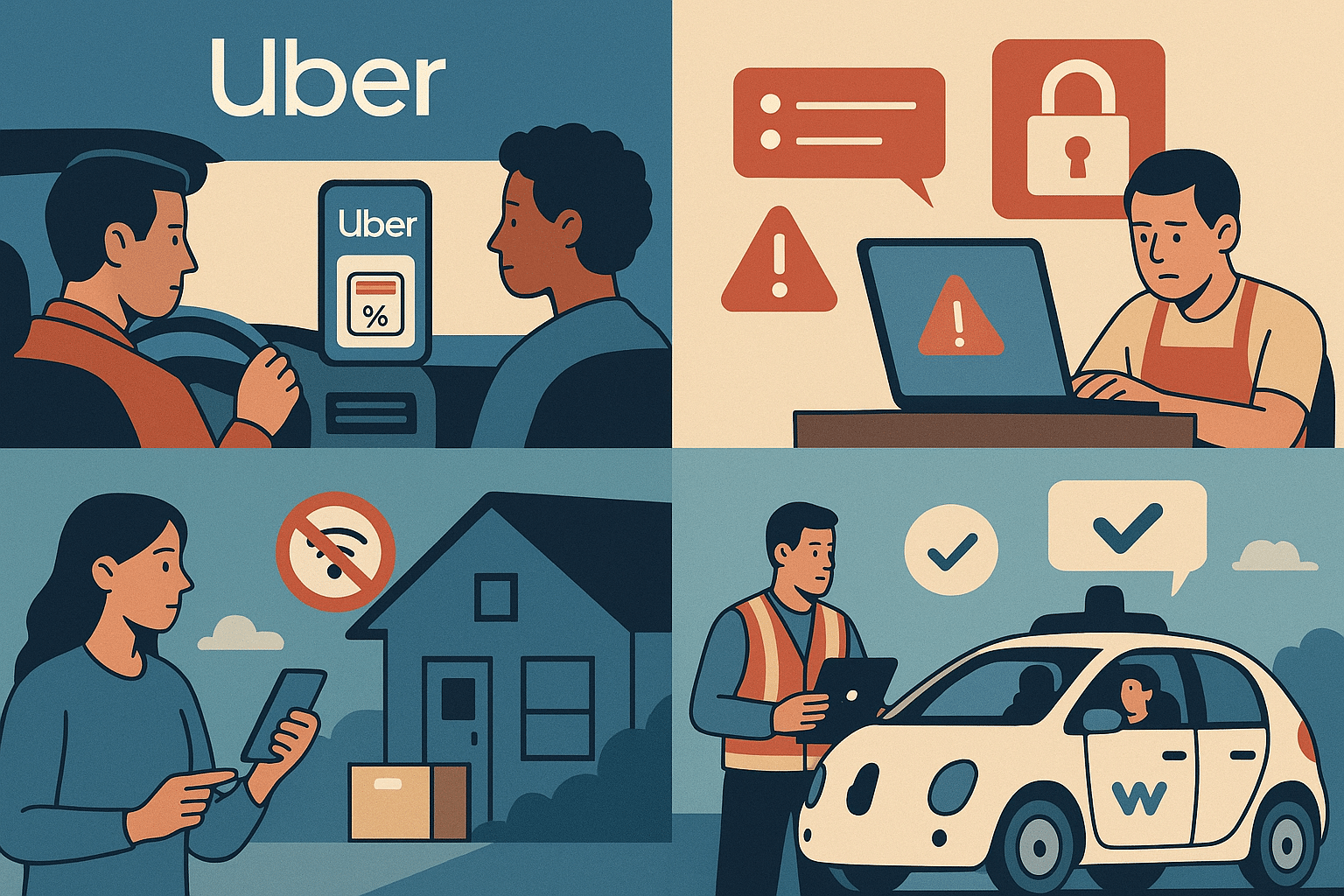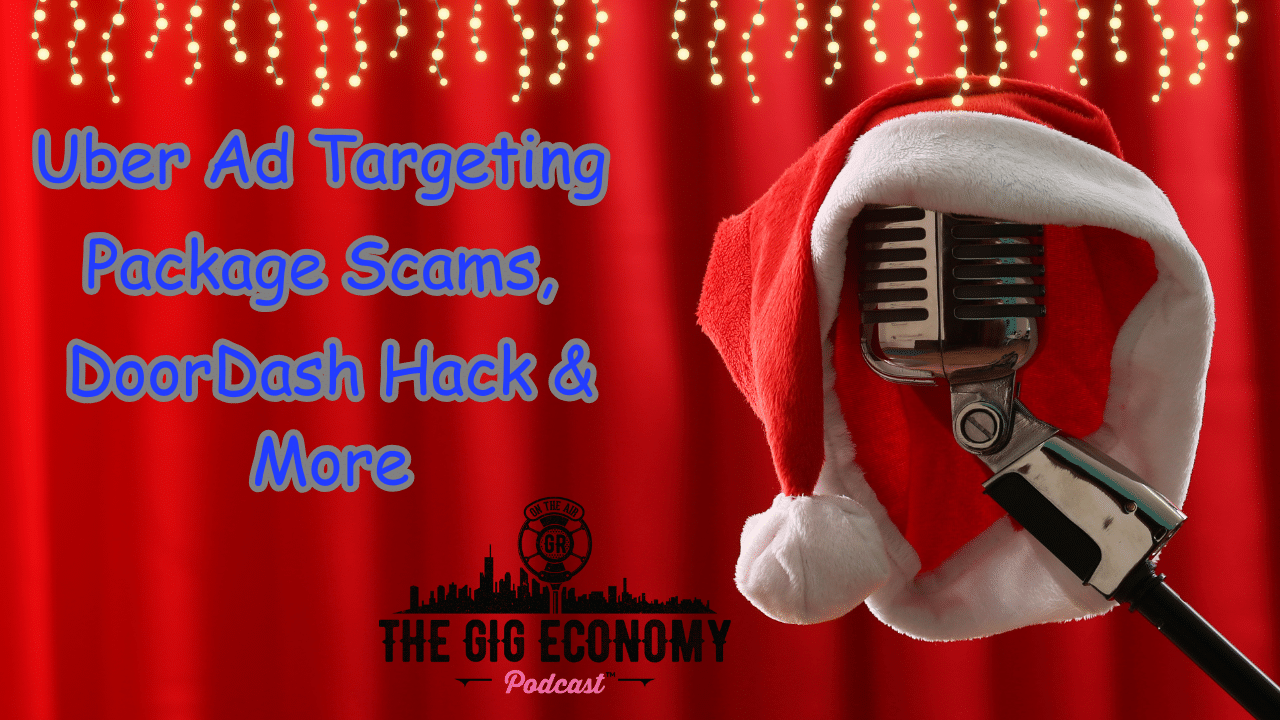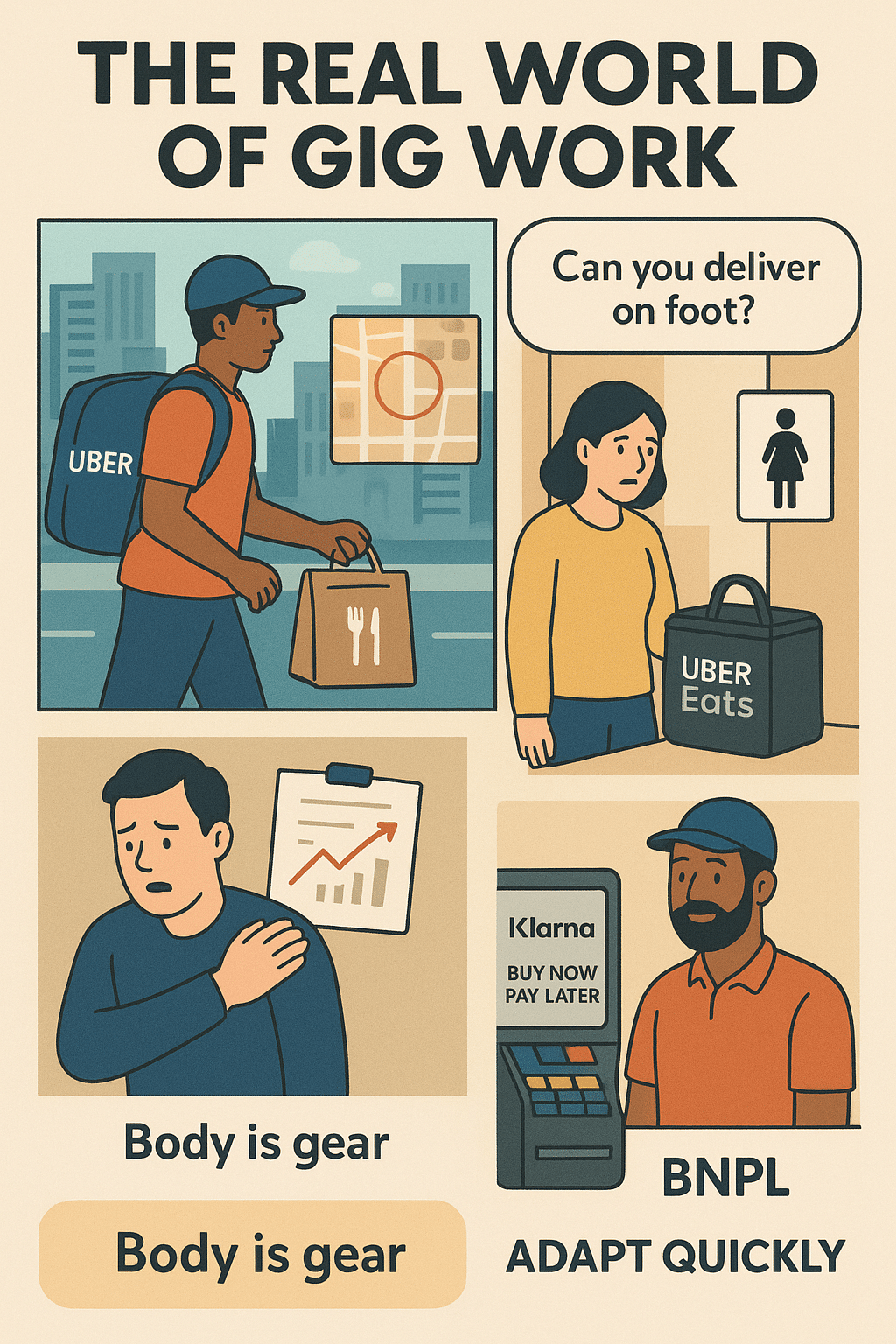
by Jason Tieri | Dec 15, 2025 | Blog
Download the audio podcast!
The latest wave of gig economy news shows how fast the space shifts between convenience, risk, and opportunity. We start with Uber’s expanding ad business, which now uses privacy‑screened trip insights to target promotions based on where riders go and what they do. On paper, the value proposition is clear: timely coupons tied to places you already visit and campaigns that reflect local patterns. In practice, riders worry about how much location data is inferred, while drivers wonder who benefits from ads that monetize their work with no revenue share. When ad revenue approaches billions, trust hinges on transparent policies, opt‑outs that are easy to find, and clear lines between anonymous trend data and personal behavior. Riders want relevance without surveillance; drivers want fair compensation when platforms profit off their routes.
Security concerns don’t end with ads. DoorDash account takeovers are draining restaurant payouts when attackers reset credentials and swap bank details. This isn’t a breach of DoorDash systems per se; it’s basic credential theft that exploits reused passwords and weak email security. The fix starts with non‑negotiables: unique passwords stored in a manager, mandatory two‑factor authentication on every merchant and driver account, and account‑change alerts that require out‑of‑band verification before bank info is updated. Restaurants also need daily payout reconciliations and a named owner for platform security so problems are spotted within hours, not weeks. Platforms can help by making 2FA default, requiring identity rechecks for banking changes, and proactively flagging unusual payout patterns.
At the curb, theft is getting smarter. Porch pirates are now using Wi‑Fi jammers to knock out cameras, leaving homeowners with corrupted clips and missing packages. The practical defense is layered. Hardwired cameras and local recording resist jammers better than Wi‑Fi‑only devices. Mixed networks, cameras on different bands, and backup cellular recording add resilience. For deliveries, secure options like Amazon lockers, controlled access delivery, or smart garage drop‑off cut risk by removing the package from view. Even simple tactics—setting a predictable delivery window when someone is home or using a low‑cost lockbox—shrink the attack surface. The goal isn’t perfect security; it’s stacking enough friction that your house isn’t the easy target on the block.
Autonomy brings its own surprises. A Waymo roadside tech shared how often he’s called out to close a door, unjam a seatbelt, or tidy a cabin so the car can depart. It’s a reminder that “driverless” still needs people. The real question is service quality at scale: who cleans the cars, how quickly do issues get resolved, and will platforms enforce cleaning fees so passengers don’t treat robotaxis like trash cans? Without consistent standards and accountability, the rider experience will suffer long before autonomy replaces human drivers. And in the meantime, drivers can still find value in the ecosystem—from side income like in‑car ads or even license plate scanning hardware for repo networks in dense cities—if the numbers pencil out and local laws allow it.
Culture and perception also matter. A viral clip mocked men over 30 working full‑time on Uber Eats, calling it “not a real job.” That attitude ignores economic reality and the upside of flexible work. The smarter frame is sustainability: earnings after expenses, safety, and a path to stability. Many drivers build hybrid portfolios—rideshare on busy weekends, food delivery on icy nights, retail parcel routes during holidays. Choice is the strength of the gig economy. Rather than shaming, the conversation should center on pay transparency, fair deactivation policies, and tools that help workers optimize routes, avoid risk, and upskill into better‑paid tasks. Flexibility without dignity isn’t a win; neither is stability that can’t pay the bills.
Finally, we’re watching AI creep from curiosity to utility. Instacart’s integration with ChatGPT promises to turn meal ideas into shoppable carts without app‑switching. If it’s seamless, it will normalize conversational commerce: “Plan a 30‑minute high‑protein dinner for four, under $25, and order it.” The risk is adding steps or creating a privacy tax. Done right, AI will compress decision‑making and reduce friction for shoppers and gig workers alike, surfacing clear substitutions, store‑level availability, and realistic ETAs. Done poorly, it’s one more interface between you and your groceries. The throughline across all these stories is simple: the best tech feels invisible, the best policies protect people by default, and the best platforms share value when they monetize our time and data.

by Jason Tieri | Dec 15, 2025 | Podcasts
Everything Gig Economy Podcast Related: https://gigeconomyshow.com/
Download the Audio Podcast: https://thegigeconomypodcast.buzzsprout.com
Love the show? You now have the opportunity to support the show with some great rewards by becoming a Patron. Tier #2 we offer free merch, an Extra in-depth podcast per month, and an NSFW pre-show https://www.patreon.com/thegigeconpodcast
Newsletter link: https://bit.ly/gigeconomynewsletter
Octopus is a mobile entertainment tablet for your riders. Earn 100.00 per month for having the tablet in your car! No cost for the driver!
https://playoctopus.page.link/HD2FBKJzFqRR35YE9
Want to earn more and stay safe? Download Maxymo https://middletontech.com/gigeconomypodcast
Community Facebook Group: https://www.facebook.com/groups/451789943399295/
The Gig Economy Podcast Group Download Telegram 1st, then click on the link to join. https://t.me/joinchat/R42wUR2QGhCi2gBD
TikTok: https://www.tiktok.com/@gigeconomypodcast?
Subscribe on Youtube https://www.youtube.com/channel/UCK_bV7j7o1BzWtB4mt_4R8Q?view_as=subscriber
This podcast is produced by Hey Guys Media Group LLC http://www.heyguysmediagroup.com
Want to start your own podcast? Reach out to them today!

by Jason Tieri | Dec 8, 2025 | Blog
Download the audio here!
The real world of gig work rarely fits a neat script, and this episode shows why. We open with a year-end mashup and an eyebrow-raising question: can you deliver on foot? In Tokyo, yes—Uber Walker is a thing—but that doesn’t translate to most U.S. markets. The hosts weigh the viability of hyper-dense delivery zones, where a four-block radius makes walking feasible, and contrast it with sprawling American cities. The takeaway is simple: logistics live and die by density. If the map is tight, walking can be fast and profitable; if it’s wide, you’re burning minutes for pennies. That nuance matters for new drivers who confuse platform rules, local demand, and what “works” on paper versus the street.
From there the conversation turns to a moment every customer fears: the delivery bag entering the bathroom. It’s not just gross; it’s an avoidable mistake that erodes trust in the entire delivery chain. The hosts push basic food safety: never bring an insulated bag into a restroom, keep separation between personal needs and customer goods, and choose pickups that let you wash hands properly. They also mention how indoor pickups beat drive-thrus when you need a restroom and a reset. It’s a practical snapshot of the hygiene calculus gig workers face, underscoring that speed shouldn’t trump sanitation. In a trust-based service, small lapses can ripple into big reputational damage—online and at the door.
Life bleeds into work, and the hosts share a rough stretch of illness and a painful bout of frozen shoulder. It’s an unglamorous reminder that gig workers are their own HR, PTO, and backup plan. A steroid shot and PT might avert surgery, but the downtime is real. The conversation nudges a larger point: build cushions. That means an emergency fund, ergonomic habits (seat positioning, lifting technique, bag straps), and realistic schedules that allow recovery. The body is gear, and ignoring maintenance costs more than lost hours. Even a small tweak—choosing shorter routes, more indoor pickups, or less heavy grocery runs—can keep someone on the road without a long layoff.
There’s levity too: a defense of bidets as the logical hygiene upgrade that Americans chronically ignore. It’s comic relief with a practical edge—washing beats wiping for cleanliness and comfort. Funny as it sounds, these habits impact driver morale on long shifts and shape which locations they prefer. The more a driver can count on clean facilities and good tools, the better the customer experience. A rested, comfortable driver is a safer driver, and that cascades into fewer errors, less cross-contamination, and a more predictable rhythm during peak times.
Then comes a time capsule: a vintage clip of Travis stumbling through an early Uber Eats explanation, implying food rides around waiting to be ordered. The hosts debate whether it was a bit or a blunder, but the real insight is how easily messaging can miss when a product is half-formed. Logistics need clarity: who cooks, who packs, who carries, and when the clock starts. Precision builds trust for restaurants, drivers, and diners. Confused pitches yield unrealistic expectations—like on-demand casseroles magically appearing from a glove box. This is a masterclass in why platform language matters, especially when it governs how workers plan and customers judge wait times.
Finally, they break down DoorDash’s partnership with Klarna for buy-now-pay-later at checkout. Drivers worry about tips; hosts argue volume may rise if customers can split payments interest-free. The nuance: BNPL probably helps large grocery baskets more than small fast-food orders, and it may skew tips downward on tight budgets. Still, more orders can lift driver earnings in aggregate, if platforms surface tip prompts and reward on-time, high-rated deliveries. The conversation lands on a pragmatic middle: BNPL is a tool. Used wisely, it eases cash flow and grows demand; used poorly, it invites overconsumption and delayed regret. For drivers, the best move is to adapt quickly—screen orders by payout, watch new patterns in your zone, and chase the baskets where financing actually increases payouts.

by Jason Tieri | Dec 8, 2025 | Podcasts
Everything Gig Economy Podcast Related: https://gigeconomyshow.com/
Download the Audio Podcast: https://thegigeconomypodcast.buzzsprout.com
Love the show? You now have the opportunity to support the show with some great rewards by becoming a Patron. Tier #2 we offer free merch, an Extra in-depth podcast per month, and an NSFW pre-show https://www.patreon.com/thegigeconpodcast
Newsletter link: https://bit.ly/gigeconomynewsletter
Octopus is a mobile entertainment tablet for your riders. Earn 100.00 per month for having the tablet in your car! No cost for the driver!
https://playoctopus.page.link/HD2FBKJzFqRR35YE9
Want to earn more and stay safe? Download Maxymo https://middletontech.com/gigeconomypodcast
Community Facebook Group: https://www.facebook.com/groups/451789943399295/
The Gig Economy Podcast Group Download Telegram 1st, then click on the link to join. https://t.me/joinchat/R42wUR2QGhCi2gBD
TikTok: https://www.tiktok.com/@gigeconomypodcast?
Subscribe on Youtube https://www.youtube.com/channel/UCK_bV7j7o1BzWtB4mt_4R8Q?view_as=subscriber
This podcast is produced by Hey Guys Media Group LLC http://www.heyguysmediagroup.com
Want to start your own podcast? Reach out to them today!

by Jason Tieri | Nov 24, 2025 | Blog
Download the show here!
The gig economy keeps rewriting its own rules. This week’s headlines showed why: a viral DoorDash incident turned indictment, a naked stranger jumped into a delivery van and crashed it, and another self‑driving car froze while backing down an alley. Underneath the chaos sits a serious question for workers and customers: what actually makes the job safer, more predictable, and worth the time? Safety tools can help, but culture and incentives matter more. If drivers feel pressured to capture content over calling support, or to leave keys and phones within reach during a drop, technology won’t fix judgment. Clear policies, better training, and practical habits—like locking doors, removing keys, and refusing unsafe requests—change outcomes in the real world far more than any push notification.
Legal and labor winds are shifting too. New Zealand’s top court just ruled several Uber drivers are employees, opening the door to wage claims and leave benefits. While limited to a small group for now, the logic can ripple across regions as unions test frameworks that redefine platform work. The tension is obvious: flexibility keeps supply fluid, but fragmented protections leave workers exposed to injury, downtime, and algorithmic volatility. Policymakers and platforms must meet in the middle with portable benefits, transparent deactivations, and dispute paths that don’t require viral videos to be heard. When regulation lags, localized rulings become the map; expect more test cases that challenge the contractor model one city at a time.
Autonomy remains the loudest promise, but the economics bite back. Lyft’s leadership thinks even 10 percent of trips from self‑driving by 2030 is ambitious. Why? Fleets are expensive to buy, maintain, clean, fuel, and insure—costs that drivers currently absorb. Meanwhile, AVs still struggle with edge cases: complex alleys, surprise pedestrians, and unpredictable human behavior. Highways are easier to control but risky at speed, and geofencing limits real utility. That doesn’t mean autonomy stalls forever. It means the near‑term path is hybrid: AV pilots in constrained zones paired with human surge capacity and niche use cases. For riders, trust will build in increments—shorter trips first, then airport runs—only as reliability beats the anxiety of an empty front seat.
On the earnings side, smart stacking still matters. If 84 percent of riders never compare Uber against Lyft, that’s a pricing blind spot drivers feel in the form of uneven demand and late‑night lulls. Riders should check both apps—price and ETA often diverge—then book fast to avoid the seesaw. Drivers can add passive income with in‑car tablets that run trivia and ads, integrate tips, and work whether the ride is quiet or chatty. It isn’t life‑changing money, but in thin-margin work, small edges add up: quicker turnarounds, better ratings from a good passenger experience, and a tip flow that doesn’t depend on awkward prompts. Every minute saved compounds by the end of the night.
Data security is the new seatbelt. DoorDash’s recent leak reportedly spared SSNs but exposed names, phones, and addresses—still enough for scams, doxxing, and harassment. The best defense is boring: unique passwords, MFA on every platform, and zero clicks on shipment emails, bank alerts, or driver “bonus” links without verifying the sender. Social engineering works because urgency bypasses judgment, especially during holidays. Drivers should assume public visibility: plate numbers, dash cams, and storefront cameras have made anonymity obsolete. Keep interactions professional, leave at door when requested, and document safety issues for the platform and the police—not TikTok. Clout isn’t a shield; it’s a subpoena magnet.
Partnerships continue to blur retail and delivery. DoorDash moving into apparel with Old Navy shows how off‑menu categories fill the slow hours and diversify demand. That’s good for drivers when batches are sensible and pickup processes are tight; it’s bad when stores lack staging, communication, or training. The broader retail turn is clear: curbside and last‑mile convenience will win shoppers who value time over browsing. Some retailers will resist to preserve impulse purchases, but consumer behavior is relentless. The platforms that standardize pickups, support workers with reliable contact flows, and resolve returns cleanly will grab market share. For the rest of us, the rule stands: safety first, cash flow second, content last.





